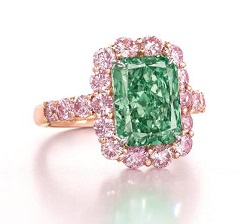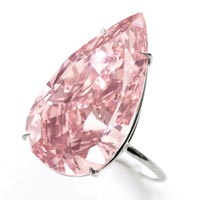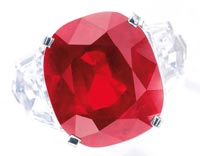 Diamonds at Auction — Big gems, big prices, and the trickle-down effect
Diamonds at Auction — Big gems, big prices, and the trickle-down effect
Just last May "The Aurora Green" fetched $16.8 million at Christie's Hong Kong auction, setting a world record for a green diamond. Jewelry of that value rarely crosses an agent's desk, but you may need to cover jewelry bought at auction. It turns out that those stratospheric auction prices can have an effect on gem values down the line.
Large, public jewelry auctions are a relatively recent phenomenon. Big players like Christie's and Sotheby's date back to the 18th century, and for about 200 years the only jewelry items they handled were part of the large estates of titled society. The auctions were fairly private and known mainly to likely buyers.
The first "celebrity" gem auction was in 1969, when a 69.42 ct diamond made worldwide headlines by becoming the first diamond to sell for over a million dollars. In fact, the cleaving of the rough for this gem had been done before television cameras. The gem was eventually bought by Richard Burton for Elizabeth Taylor, and some 6,000 people lined up at Cartier's to view it.
Public auctions and the "auction effect"
As jewelry auctions grew, they gained media attention. Hammer prices were published and private buyers began buying gems for investment. Gem dealers noticed what they termed the "auction effect" — price bumps for top-quality gems after similar goods brought high prices at public auctions.
In 1979 a 4.12 ct Burmese ruby sold for $414,832. This was the first time a colored gem sold at auction for more than $100,000 per carat. But within a few months, values fell nearly 50%. The auction effect had initially pushed prices up, but the market had provided an adjustment.
By the late 1980s fancy color diamonds, once available only to collectors and connoisseurs, were appearing at public auctions. Auction catalogs, which used to give little information beyond gem type and carat weight, began to have detailed quality descriptions, origin reports, and background histories for gems like Burmese rubies and Kashmir sapphires. The descriptions were accompanied by lush illustrations.
Whereas they formerly concentrated on estate jewelry, auction houses now sought newly mined and cut stones, and even commissioned jewelry houses to create major ruby, sapphire, and emerald pieces. De Beers resumed selling the very large diamonds it had stockpiled during the early 1980s, when prices were depressed. Wealthy buyers engaged in bidding competitions, which drove prices ever higher.
Publicizing the results of auctions increased the market for colored diamonds and other colored gems. It also broadened awareness of the high premiums for such gems as Burmese rubies, Kashmir sapphires and Colombian emeralds. If these sales had been private, they would have had little influence on the market.
Value of Provenance
The 1987 sale of the Duchess of Windsor's jewelry was a major publicity event. Advance media coverage included histories of the major pieces, descriptions of signed pieces by Cartier and Van Cleef & Arpels, and even the notoriety of some of the buyers, such as Elizabeth Taylor. Sales from the estate totaled $50.3 million—seven times the pre-sale estimate.
It is widely understood that the jewelry's extraordinary provenance generated bids many times the intrinsic market value of the pieces. Whether such pieces retain their prestige and auction value is an open question.
The Duchess of Winsor had a brooch showing a diamond-studded panther crouched on a perfectly round 152.35 ct star sapphire. The piece became the envy of collectors, and Cartier produced more versions of it. However, none of the subsequent versions could match the original, if only because of the size and quality of the sapphire it held.
One of these later versions was involved in an insurance dispute. It was made by Cartier, but had a smaller sapphire and was not of the same quality and weight. An expert remarked that these later pieces were like looking at an obvious copy of a famous painting. And, as collectors should know, any replica, any knockoff regardless of quality, cannot match the original in provenance.
A striking illustration of the draw of provenance was the 1996 auction of items from the estate of Jacqueline Kennedy Onassis. Reports of the event described an atmosphere of "frenzied bidding" at Sotheby's. Even household items brought prices of 10 times their estimated value, or even much more.
A kunzite ring, bought by President Kennedy for his wife but never given to her, was valued in the auction catalog at $6,000-$8,000. It sold for $431,250 – some 60 times the pre-auction estimate.
The auction house had based its estimates on the intrinsic value of the items, and few of the purchases were considered antiques or unusual works of art. One account of this auction described the buyers as "looking for pieces of Camelot." That experience, that piece of history, is what they paid for. It is unlikely that the Jackie Onassis pieces will retain their auction prices.
But as one dealer remarked, the Windsor jewelry auction boosted prices and demand, and it "got the world emotionally involved in jewelry."
See below for insuring jewelry bought at auction.
FOR AGENTS & UNDERWRITERS
Few jewelry items are as unique and outrageously expensive as those discussed above, but those famous pieces can affect the jewelry market as a whole.
If you are insuring expensive jewelry bought at auction, be aware that the auction price does not necessarily reflect the value of the jewelry. Bidders can get caught up in the moment of history or in sentimentality or a bidding contest. But afterwards, realistic market values set in.
For purchases based on provenance, the jewelry's value may fall if the celebrity who owned it fades from public interest. Or the value may rise dramatically over time, as with the Duchess of Windsor flamingo piece pictured here.
Also, a gem type, such as a colored diamond, may become popular (and hence, valuable) because a public figure is seen wearing it. But it can drop in value when another fad hits the market.
High-value jewelry sold at auction often comes with a lab report. Be sure to verify the report using these links to the reliable gem labs. If there is no lab report, or if the client submits a report from a lab other than one of those listed below, ask for a report from one of these labs before insuring the jewelry.
These are the major trustworthy labs:
GIA
AGL
Gübelin
AGS Report Verifcation
GCAL Certificate Search
For high-value jewelry, ask for two appraisals from reliable appraisers who are independent of the seller. Be wary if the appraiser's valuation does not come near the auction price.
The best appraisal includes the JISO 78/79 appraisal form, and is written by a qualified gemologist (GG, FGA+, or equivalent) who has additional insurance appraisal training. One course offering such additional training is the Certified Insurance Appraiser™ (CIA) course of the Jewelry Insurance Appraisal Institute.
If the jewelry has colored gemstones, the appraiser should be one who is familiar with colored gems and their value in the marketplace.
A buyer at auction pays not only the hammer price but also pays to the auction house a commission based on the price of the piece. So the cost to the buyer is more than the auction price. Be on guard that the insured valuation is for the value of the jewelry, not the cost of the purchase.
NOTE: Jewelry bought through online auction sites or online retailers presents other serious problems for both the buyer and the insurer. Before covering online purchases, see Online Jewelry—Buying it and Insuring it and Appraisal Inflation—It Keeps on Keeping on.
FOR ADJUSTERS
Examine all documents on file. If the jewelry was bought at auction, its value may have changed dramatically from the time of purchase. Use a reliable appraisal description to determine value at time of loss.
Jewelry based on "famous" jewelry usually cannot match the original. Large, high-quality gems are often no longer available — at any price. And the workmanship may not be as good.
©2000-2025, JCRS Inland Marine Solutions, Inc. All Rights Reserved. www.jcrs.com






